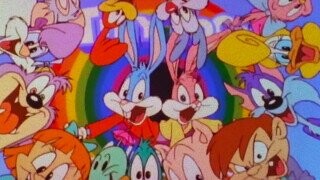‘We’re All A Little Looney!’ 15 Trivia Tidbits About ‘Tiny Toon Adventures’

They’re tiny, they’re toony, and they’re back. After three decades in detention, the gang from Tiny Toon Adventures has finally returned for the new Max/Cartoon Network series Tiny Toons Looniversity. If you haven’t checked it out yet, gear yourself up with some tidbits about the original 1990s classic, including the creator’s favorite student and how involved Steven Spielberg was with the series. And now our intro’s done.
Click right here to get the best of Cracked sent to your inbox.
The Birth of Buster and Babs
While Tiny Toon Adventures was created and developed by Tom Ruegger, the genesis for the show came from Spielberg and Warner Bros. President Terry Semel. Legendary animation writer Paul Dini told Comics Scene magazine that Semel was looking to “inject new life into the Warner Bros. Animation department.”
No Little Bugs
Dini also said of Tiny Toons Adventures, “When Tiny Toons was announced, everybody automatically felt it was going to be little Bugs, little Daffy, little Porky, and that was never really the intention. The idea was to create new characters that might be junior versions of the characters, but different personalities.”
Babs Is Best
Of the various characters created for Tiny Toons, Ruegger cites Babs Bunny as the most significant due to her being the first lead female character in a Warner Bros. cartoon and being genuinely funny.
ACME Looniversity’s Teaching Staff
In a recent interview with Cracked, Ruegger said Warner Bros. only required him to bring in Bugs Bunny as a teacher. The remaining Looney Tunes staff at ACME Looniversity were up to him.
Drawing from the Classics
Jean MacCurdy, executive producer on Tiny Toons Adventures, once explained, “The original directors (of Looney Tunes) Tex Avery, Bob Clampett, Friz Freleng, Chuck Jones, Bob McKimson, each one of those brought to the Looney Tunes something unique. Chuck had the wit and sophistication, Friz had the music, and Bob Clampett had the insanity. Tex had the gags. We tried to take a little bit from each of them when we went ahead with Tiny Toons.”
A Familiar Approach
“One of the advantages we had at Warner Bros. was that they really wanted to make Tiny Toons in the style that the old cartoons were made in that they had units that had individual story people and layout people. It was this great process of discovery,” said Dini.
No Skimping on the Music
MacCurdy recalled in an interview that, “When we first started Tiny Toon Adventures, we had a meeting one day with Mr. Spielberg, and the issue of music came up. We were talking about how important (composer) Carl Stalling had been to the original Looney Tunes, and Steven said, ‘Of course, we’re going to have a full orchestra for these cartoons.’” MacCurdy, who was in charge of the budget, resisted, saying that things just weren’t done that way anymore, but Spielberg replied by simply stating, “No. We’re going to have a full orchestra,” and that was that.
The Opening Theme
The writer of Tiny Toons’ earworm theme song was Bruce Broughton, an Oscar-nominated composer.
Spielberg Was Very Involved
“Steven Spielberg was very involved in Tiny Toons,” writer and producer Sherri Stoner has explained. “He was very involved in the development of the characters with Tom (Ruegger) and some of the other people. When I was onboard, we would send him a script. We’d get it over to Amblin around 5, and usually, by 8, he’d be calling with notes on it. Nobody does that.”
Returning Cast Members
While almost every Looney Tunes character who appeared on Tiny Toons was recast — mostly due to Mel Blanc dying in 1989 — two actors did return to voice their classic era characters: Stan Freberg as Pete Puma and June Foray as Granny.
Spielberg’s Cameo
Spielberg had a cameo on the show as a white rabbit that was clearly meant to be Roger Rabbit.
One Episode Was Created by Three Teenage Fans
In 1991, three 13-year-old girls from Waynesboro, Virginia, wrote and drew a fan episode of Tiny Toons and sent it to Spielberg. Astonishingly, the story made it all the way to Spielberg, who decided to make it into an episode. Season Two’s “Buster and Babs Go Hawaiian” was credited to the girls — Renee Carter, Sarah Creef and Amy Crosby — who were also caricatured in the episode along with Spielberg (who played himself).
The Series Was Followed by Two Specials
While the main series ended in 1992 after 98 episodes, the characters returned in two animated specials: Tiny Toon Spring Break in 1994, and Tiny Toons’ Night Ghoulery in 1995.
Elmyra’s Second Act
Six years after Tiny Toon Adventures, Elmyra returned for Pinky, Elmyra and the Brain. The cartoon was a restructuring of Pinky and the Brain stemming from Kids WB’s desire for more recurring characters than the two titular mice. No one opposed this idea more than the writers. They even retaliated by adding this line to the new theme: “So Pinky and the Brain / Share a new domain / It’s what the network wants / Why bother to complain?”
Ruth Clampett’s Seal of Approval
Clampett, daughter of one of the most celebrated Looney Tunes directors, Bob Clampett, said of Tiny Toon Adventures, “A lot of people I know talk about the early Looney Tunes cartoons and that there will never again be cartoons as great as that — that only the old stuff is good — and I don’t agree with that. When I imagine what it must have been like for Steven Spielberg and the amazing team they put together for Tiny Toons, the challenge that they had — to create a new property that was inspired by the Looney Tunes cartoons, but really needed to stand on its own and have its own spirit — that must have been incredibly intimidating, a really daunting task, yet, they did it and they did a beautiful job.”